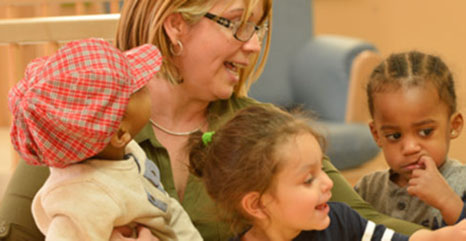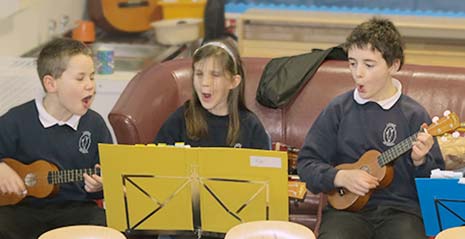Singing new songs
| April 2018“The wheels on the bus,” “Wind the bobbin up,” “Baa Baa black sheep,” “Polly put the kettle on,” “Hickory dickory dock”…All good songs, but not enough. How many children’s songs do you know? Actually we all know many more songs than we think we do, but we just don’t sing them as often as we could! We fall back on the ones we know and the ones that the children know. Why is it important to increase our own and our children’s repertoire of songs? Why is it important that we sing new songs?
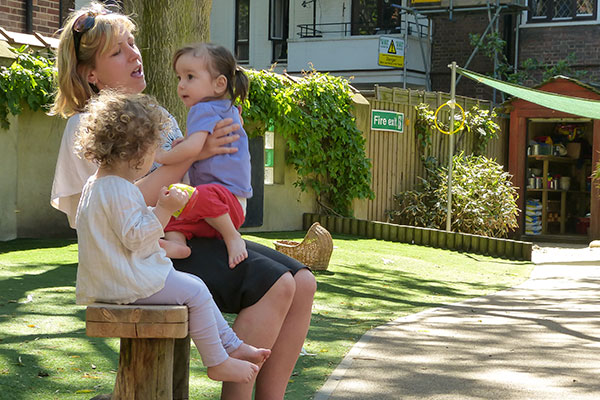
The value of singing lots of songs and giving children a large song repertoire
Most adults know that singing makes us happier by causing endorphins to flow. It helps us breathe efficiently and it enhances our brain function and general well-being. With all the many benefits of singing and music making, it seems sensible to give priority to it in the curriculum. In some countries such as Hungary, singing with young children is seen as so important to their development that you can’t be an early years practitioner without being able to sing in tune, know at least a hundred songs and play an instrument! Yet the emphasis on music in the training of early years practitioners in the UK is negligible.
Singing and music are part of children’s development. We miss opportunities for learning if we rely on singing only a limited number of the good old favourites. For example, when the children are on the seesaw, what song can we sing? When the children find and show an interest in worms, caterpillars and snails, what songs can we sing? Mini-beasts are always going to be joyfully found in digging patches and grasses and when we react to children’s ecstatic response, we deepen and extend their knowledge by teaching a song about these creatures there and then or later at together time. Have we an appropriate repertoire up our sleeves? Singing organises words and sounds for the children and allows them to deal with grammatical structures beyond their everyday ability and use a vocabulary that exceeds their own comprehension.
Think about how we can develop more of a culture of singing in our settings and sing songs about what the children are doing and are interested in. Think about the songs you know to sing in the home corner, for example:
- Rocking and lullaby songs to sing when children are cradling the dolls
- Cooking songs when children are baking
- Making cups of tea songs when children have tea parties
Think about the songs to sing outside, for example:
- When children are climbing and digging, gardening or running
- When you organise ring games
- When children are washing clothes or their bikes at the “car wash”
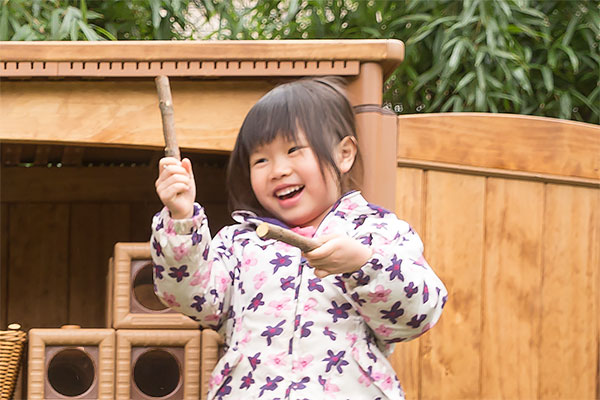
How can we learn new songs?
Learn them from each other. “But”, I hear you say, “Where do I find new songs to learn and how do I learn them as I can’t sing and can’t read music?” If we are convinced that singing and learning new songs is important, we have to do our homework.
Make a setting song book. Now is the time to make your own book of songs. If each person in the setting contributes one song and teaches it to other practitioners, you have a very good start. Laminate lists of songs and put them at adult height in all the areas inside and out, just as an aide memoire.
Learn them from songbooks. Just about every songbook published now comes with a CD, for example, songs in “Sounds like playing”. There are songs to sing about building with blocks and crates, about people who help us, about painting, digging and so on. There is a fine selection of ring games and action songs in “Singing and Rhymes for early years” and “Singing and Rhymes for tiny tots” by Geoghegan L. (2002). A&C Black publishes great music books with CDs, for example:
- Okki-Tokki-Unga: Action Songs For Children
- Sing Hey Diddle diddle – 66 nursery songs
- Apusskidu – A great collection of music hall songs, pop songs, noisy songs and happy songs.
- Play Songs and Rhymes for Babies and Toddlers
- Bobby Shaftoe clap your hands
And there are recordings of all the songs with backing tracks available on CDs as well.
Learn them from internet sites. For example: bbc.co.uk/schoolradio nursery songs and rhymes (one site has 84 songs with videos!)
Rub a dub dub, dirty socks in a tub,
Red and yellow and blue and green,
With a hole in the toes and a hole in the heel,
Wash them all till they’re fresh and clean.
Rub a dub dub, clean socks in a tub,
Hang them out in a row to dry,
With a hole in the toe and a hole in the heel,
Watch them bounce on a line up high.
If the children are interested in anything from superman to dinosaurs, you’ll find a song about it on one of these websites!
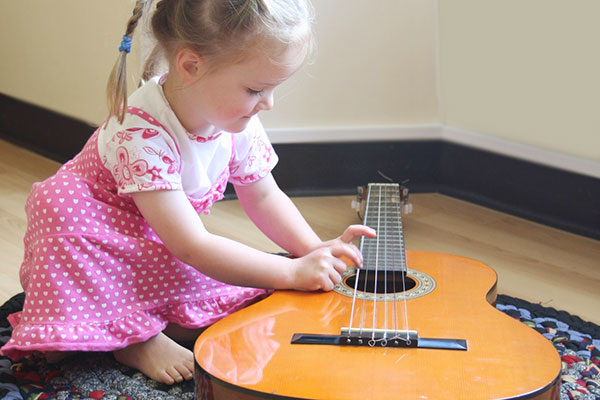
Learning in all the areas of development
In terms of consolidating the areas of the curriculum, what can be better than learning a song about it. For example:
- Number songs for counting and symbolic representation, e.g. There were 10 green bottles.
- Nursery Rhymes teach syntax and phonological awareness long before any formal teaching should be taught.
- Songs when you want to find out if all the children are present e.g. “Is Gemma here?” “Yes I’m here.”
- To signal a change in the routine; e.g. tidy up time songs. “Now it’s time to tidy up, tidy up, tidy up, so everyone is helping” to the tune of “This is the way we…”
- Songs covering information, e.g. “Old McDonald had a farm.”
- Songs for historical memory – music is a memory bank for finding one’s way about the world. In my native Scotland we have a lot of songs that tell of the triumphs and disasters of our history. In Estonia there was a singing revolution marking the end of Soviet domination!
- Folk songs inform children about the stages of life, e.g. “Old Roger is dead and he lies in his grave.”
- Ring games structure movement and working together; e.g. “There was a princess long ago.”
- Songs for fun and silliness, e.g. “Bananas in pyjamas.”
- Songs for supporting acceptable behaviour and living in a community, e.g. “This is the way we sweep the leaves”, or when the crayons spill the teacher can sing, “I’ll pick up the blue ones, the blue ones, the blue ones, I’ll pick up the blue ones, if you pick up the red.”
- Songs for helping children to keep order, e.g. “I wonder where the lego goes, when it’s time to tidy up?”
Making up songs
If you think of the old fashioned fire engine or ambulance sound “Nee Naw, Nee Naw” or the old playground chant, “na nana na na”, then you have the tune that you can use to make up songs. “What-are-you-mak-ing?” “I-have-a-ham-mer”. With just two or three notes you can begin to make up your own songs and rhythms. Children will begin to make up their own songs when they are given the permission to do so.
Songs with parents
Before leaving the subject of how important singing is in the education and development of young children, the case for involving parents and carers must be made. We now are aware that babies do not come into the world as clean slates but rather that they are “up and running” from very soon after conception and that there are powerful prenatal neural connections that form the basis for musical experiences. Babies begin “hearing” as early as 22 days after conception and their hearing is as sensitive after five months in the womb as that of an adult! So babies already have in their brains lots of sound and musical memories and associations from the world of their mothers. Professor Colwyn Trevarthen in Edinburgh as well as Papousek and others have studied the musical interactions between mother and infant showing that the babbling and mother-ese is patterned, musical in structure and amazingly universal. Parents do sing and dance with their children, but lack the confidence to call themselves musical. By developing strategies which involve parents in the musical life of the nursery, practitioners can rekindle the enthusiasm and confidence to enable them to foster and share songs and musical dialogues to the benefit of all.
There are a few strategies we can employ to involve parents.
- Invite the parents to arrive to collect their child a little earlier and have a sing-song with the children and parents.
- Write out a song of the week and give the parents a copy of the words to take home and sing with their child.
Singing all the time!
The approach of Friedrich Froebel, the 19th century German philosopher and educationist, has always influenced my thinking and teaching since I trained as a Froebelian teacher. He believed that we should start respectfully by observing children in their play to see what they know and can do already and then support them in making connections to new knowledge and experiences. Nothing can be more familiar to young children than music and movement and so it makes sense to use children’s singing and sound-making and make connections through action songs, ring games and movement and dance. Froebel believed that singing the songs and singing games he devised provided fundamental learning experiences, reinforcing the moral, social and emotional life of the child as well as the linguistic and intellectual rigour and symbolic representation. “ This little thumb”(in Froebel’s Song collection) is very similar to the song , “Tommy thumb”, a song that we sing. “Here is the beehive, where are the bees?” In this finger rhyme the hands represent the hive and the fingers hidden within, the bees. There are many songs that we sing today that use the fingers on the hands as symbols.
Singing is a natural and intuitive activity, which children engage in with great joy. It is particularly important that we capitalise on their enjoyment and use singing much more in our practice.
References
bbc.co.uk/nursery songs and rhymes: Songs from the internet
Ouvry, M. (2004) Sounds like playing: Music and the early years curriculum. London, British Association of Early Childhood Education, (tel 020 7539 5400)
Geoghegan L. (2002) Singing and Rhymes for early years and Singing and Rhymes for tiny tots
National Youth Choir of Scotland, Glasgow London Early Years Music Network (2013) What’s that noise https://youtu.be/vCdh1XDsydA Trevathen, C. (Editor) Malloch, S. (editor) (2009) Communicative Musicality: exploring the basis of Human companionship. OUP. Oxford
© Marjorie Ouvry 2017. First published in Early Days Volume 5, issue 2. Used with permission of the author and editor.

